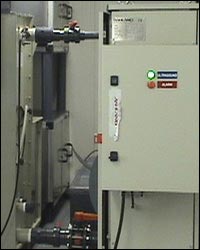Solution to “Legionella”

SONOXIDE system
As a result of the joint working between teams of experts from the Iberia Ashland Chemical, S.A. company and the INASMET-Tecnalia Technological Centre, a solution has been found to prevent the serious disease caused by the bacteria known as “Legionella” and other similar disorders.
This achievement has meant a great advance for human health. It is based on the biocidal and bacteriostatic effect of the SONOXIDE system, used in refrigeration towers of factory buildings and installations that are prone to be the focus for the proliferation of Legionnaires’ disease.
In order to validate the system, the team of INASMET-Tecnalia experts designed a refrigeration tower simulation within a biologically-isolated laboratory (P2 level). A wide range of trials were carried out in this isolated and secure system in order to determine the efficacy thereof.
Regarding the technology developed, it consists of a system based on low-intensity, high-frequency ultrasounds which, together with the introduction of micro-bubbles of air, produce an effect of photo-sonoluminiscence. The concentration of ultrasounds by constructive interference generates a pressure front that produces a decompression of the gases dissolved in the water. This wave front produces a luminous plasma around the bubbles, as well as high pressure and temperatures.
These pressures and temperatures have two effects: on the one hand, they eliminate the circulating bacteria and, on the other, they generate an oxidative stress that is transmitted throughout the water refrigeration system. This stress, together with the continuous loss of circulating bacteria throughout the system, reduces the formation of biofilm even at extremely low levels – and maintains this to such an extent that the fixing of “legionella” bacteria or any other micro-organisms needing biofilm in order to grow in the system, is impeded.
Media Contact
More Information:
http://www.basqueresearch.comAll latest news from the category: Life Sciences and Chemistry
Articles and reports from the Life Sciences and chemistry area deal with applied and basic research into modern biology, chemistry and human medicine.
Valuable information can be found on a range of life sciences fields including bacteriology, biochemistry, bionics, bioinformatics, biophysics, biotechnology, genetics, geobotany, human biology, marine biology, microbiology, molecular biology, cellular biology, zoology, bioinorganic chemistry, microchemistry and environmental chemistry.
Newest articles

High-energy-density aqueous battery based on halogen multi-electron transfer
Traditional non-aqueous lithium-ion batteries have a high energy density, but their safety is compromised due to the flammable organic electrolytes they utilize. Aqueous batteries use water as the solvent for…

First-ever combined heart pump and pig kidney transplant
…gives new hope to patient with terminal illness. Surgeons at NYU Langone Health performed the first-ever combined mechanical heart pump and gene-edited pig kidney transplant surgery in a 54-year-old woman…

Biophysics: Testing how well biomarkers work
LMU researchers have developed a method to determine how reliably target proteins can be labeled using super-resolution fluorescence microscopy. Modern microscopy techniques make it possible to examine the inner workings…





















